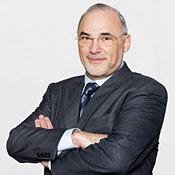New sole-CEO Leo Apotheker wants the enterprise-software powerhouse to be more responsive to customers.

| |
| |
Leo Apotheker's appointment as SAP's sole CEO is more significant than many in the IT industry realize, SAP co-founder Hasso Plattner said. How so? The 37-year-old software company needs a change agent, and Apotheker is it.
Plattner and Henning Kagermann -- who, until last week, shared CEO duties with Apotheker -- are the old guard, Plattner said in a conversation at SAP's recent Sapphire conference. Apotheker, on the other hand, doesn't have the same deep, personal ties to the company, making it easier for him to recognize the big changes needed to keep SAP relevant in a fast-changing industry. "We're not creative enough," Plattner said. Apotheker himself said the task at hand is to take SAP to the next stage of its evolution. "We started out automating back-office functions," he said. "SAP today is all about enabling clarity and transformation of business, which takes us into a whole different category of applications."
Apotheker wants SAP's culture to become more agile, responsive, and customer-centric. In one sign of that, SAP has agreed, at the behest of its customers, to meet certain performance benchmarks before it institutes price hikes for the annual maintenance fees that customers pay.
There's some change on the product front. SAP's Business Objects division recently launched an enterprise search and business intelligence tool called Explorer that utilizes an in-memory database. The company also is pushing into cloud computing and virtualization, though it hasn't fleshed out details on its strategy and deliverables.
Business Objects Explorer lets nontechnical employees search large data sets within their organizations using natural-language questions and keywords. They can compare results with other search results using bar graphs and pie charts.
| |
| |
The product is a combination of the Polestar user interface developed by Business Objects and SAP's in-memory database, Business Warehouse Accelerator, and T-Rex search engine. SAP is working with Dell, Fujitsu, Hewlett-Packard, and IBM to optimize hardware for Explorer, which it will begin selling this summer. SAP will offer a cloud-based testing environment, where customers can try Explorer with their own data.
However, the first version will work only with SAP's NetWeaver Business Warehouse, limiting its value for companies that use more than SAP as their data stores. Early testers of Explorer from Molson Coors and Sara Lee bubbled with enthusiasm. However, others wondered just how much work would be required to get the product to search for topics and words in non-SAP data repositories.
In his Sapphire keynote, Apotheker sought to "kill a rumor" about the death of Business ByDesign, SAP's ERP-as-a-service offering that was sent back to the drawing board after an unsuccessful introduction. CTO Vishal Sikka suggested SAP may need to replace as much as 70% of the internal workings of Business ByDesign to get the costs down to what SAP requires. Plattner said a market-ready product will become available within two years.
Eighty early adopters are using a prerelease version of Business ByDesign. Apotheker wouldn't disclose whether that version uses a multitenant or single-tenant configuration. "Who cares?" he said. "What matters to customers is SAP has solved some very interesting technology challenges with Business ByDesign."
SAP already offers on-demand applications in areas such as CRM and procurement, and will expand its SAP On-Demand offerings into human resources (talent management, contractor management, etc.), as well.
SAP also will deliver new hosted services with ties to its core SAP Business Suite on-premises software. Among the technologies that will help SAP do that are assets acquired from cloud platform provider Coghead earlier this year. SAP sees itself helping customers manage cloud services transactions. For example, all of Apple's iTunes orders are processed by an SAP system, as are 8 million transactions per hour from Deutsche Postbank's online banking Web site.
And don't be surprised to see SAP software running on other clouds and hosting services. Sanjog Gad, SAP's senior VP of advanced technology, is working on getting SAP software to run on Microsoft's Windows Azure platform. What's more, Sikka said many companies already develop and test their SAP implementations on Amazon Web Services before deploying them in their own data centers.
Will Apotheker make a difference? The fresh thinking toward maintenance costs is a step forward. For users not already paying an annual rate of 22% of the license cost for enterprise support, SAP plans to gradually raise them to that rate -- but only if 100 test customers see a 30% improvement in areas such as total cost of ownership with SAP's enterprise support offering, based on key performance indicators established by a third party.
Competitor Oracle would never devise a conditions-based maintenance increase, said Bill McDermott, SAP's president of global field operations. "They can't do it because they have a different business model," he said. "If you listen to [Oracle CFO] Safra Catz, you hear her say Oracle is doing so well because maintenance fees are liquid gold for them. It's liquid gold until a customer says, 'What can SAP do? Let's give SAP a call to see if they can do better.'"
SAP customers generally see the effort as positive. "I will give SAP a ton of credit, because they listened to the feedback of their customers," Dow Corning CIO Abbe Mulders said. "Enterprise support has been a very controversial issue over the last year, but SAP didn't have to put those metrics in place. No one else in the industry today has any kind of measures on maintenance dollars."
That optimism was tempered with skepticism. Some CIOs questioned the quantitative success of benchmarks on such things as total cost of ownership. It's up to Apotheker and the rest of SAP to win them over.
Attend a Webcast on reducing data management costs and focusing on business goals. It happens June 11. Find out more and register.
About the Author(s)
You May Also Like








